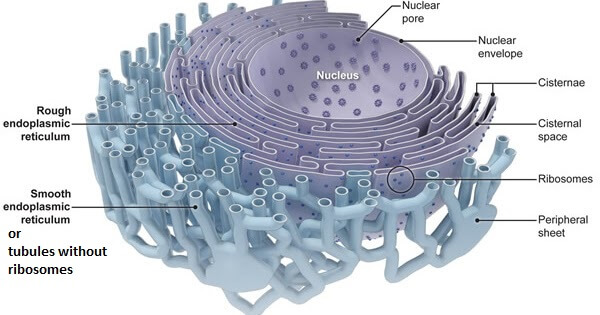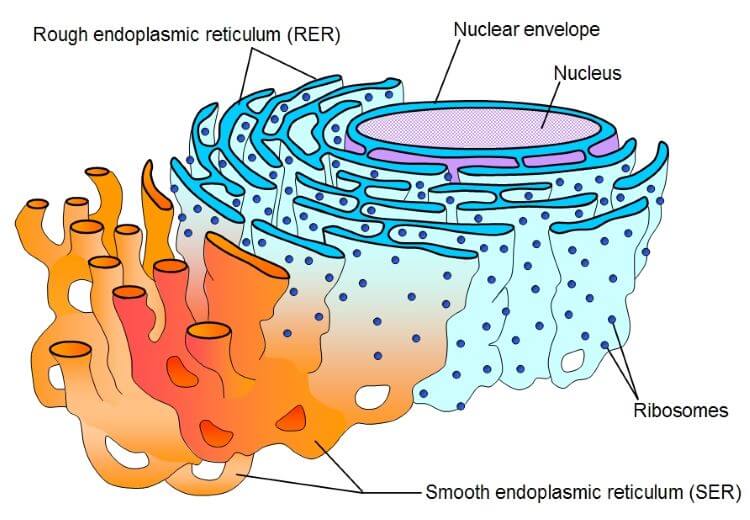Endoplasmic Reticulum (ER) | Cell organelle
It is a membrane-bound cell organelle that forms an interconnected network of cisternae (flattened sacs) and tubules (tubes). Endoplasmic means inside the cytoplasm and the meaning of reticulum is a network. It originates from the nuclear membrane through budding and folds in on itself to create an internal space called the lumen.
ER was observed for the first time by Garnier in 1897. However, the ultra-structure of ER was given by Keith R Porter, Albert Claude and Ernest F. Fullam in 1945. And, the term Endoplasmic Reticulum was given by Porter. It is present in all eukaryotic cells except for some germinal cells and mature red blood corpuscles (RBCs) of mammals. It is absent in prokaryotic cells as they do not contain any membrane-bound structure.
Structure of Endoplasmic Reticulum:
ER mainly consists of cisternae, tubules and vesicles.

- Cisternae: They are unbranched flattened sac-like structures with a narrow lumen. They are studded with ribosomes. They originate from the nuclear membrane through blobbing or evagination (turning outward) of the nuclear membrane. Cisternae are parallel to each other and are interconnected with each other to form a network. Besides this, the ribosomes are studded or embedded on the surface of a cisterna (plural: cisternae). Their lumen is narrow and it ranges from 40 to 50 micrometre. Cisternae are closer to the nucleus as they originate from the nuclear membrane. It divides the cytoplasm into two parts; cytosol (normal cytoplasm) and cisternal lumen or space. Furthermore, the cisternae are also called ergastoplasmic sacs as they produce granular substances or chemicals.
- Tubules: They are branched and more diverse in shape than cisternae or vesicles. They don't have ribosomes on their surface as tubules are formed from cisternae when cisternae lose their ribosomes. They are closer to the plasma membrane and their lumen is wider as compared to cisterna's lumen. Their lumen ranges from 50 to 100 micrometre.
- Vesicles: They are spherical structures located closer to cisternae. Their diameter is around 50 to 500 micrometre. They also have ribosomes attached or studded on their surface and usually remain close to the cisternae.
The lumen of cisternae is continuous with the perinuclear space so it is known to be attached to the nuclear envelope or membrane. Its other side that is made of tubules is attached to the plasma membrane. So, from one side, it is attached to the nuclear membrane and from the other side, it is attached to the plasma membrane.
Types of Endoplasmic Reticulum:
The endoplasmic reticulum is of two types as it has two distinct regions that vary in structure and function and the presence of ribosomes. However, it has two types based on the presence of ribosomes, which are described below;

i) Rough Endoplasmic Reticulum (RER):
Its surface is studded or embedded with ribosomes, so it is called rough endoplasmic reticulum or granular endoplasmic reticulum. It comprises the cisternae part of the ER and looks like a series of canals. The ribosomes are attached to its surface by a protein called ribophorin and its lumen is continuous with the outer membrane of the nuclear envelope. So, it is close to the nuclear membrane or nucleus. It can be viewed only by using an electron microscope.
RER acts as the site of protein synthesis or they are specialized for protein synthesis. So, the protein-synthesizing cells like fibroblasts and beta cells of islets of Langerhans contain more number of the endoplasmic reticulum. The proteins formed at RER may become part of the cell membrane or they are secreted out from the cell through the cell membrane. So, it also helps in deciding which proteins should remain in the cell and which should leave the cell. Besides this, it takes part in the production of antibodies, insulin and also aid in transporting proteins into the smooth ER.
ii) Smooth Endoplasmic Reticulum (SER):
It does not have ribosomes on its surface so it has a smooth surface as compared to rough ER. It is mainly composed of tubules and is located close to the plasma membrane. SER makes lipids and carbohydrates. It is not involved in protein synthesis. Lipids are fat-based molecules that are required for energy storage, membrane structure, and communication.
SER helps to detoxify the cell. For example, the liver cells have a large amount of SER as they carry out most of the body's detoxification. Furthermore, the cells, which synthesize more lipid, have more amount of SER such as adipocytes and liver cells. The cells which produce steroid hormones like testosterone also have more SER such as leydig cells. Similarly, follicular cells, that produce steroid hormones like oestrogen and progesterone, would have more SER. Furthermore, SER when present in the striated muscle cells termed as sarcoplasmic reticulum.
Functions of Endoplasmic Reticulum:
i) Functions of Smooth Endoplasmic Reticulum:
- Smooth ER helps in the synthesis of lipids such as phospholipids and cholesterol.
- It also assists in the formation and secretion of steroid hormones and metabolism of the carbohydrates.
- It is responsible for storing and releasing calcium ions that are needed for the muscular and nervous system.
- It forms desmotubules, which are strands of the endoplasmic reticulum that runs through plasmodesmata, (a connection between two adjacent cells through which transport of materials occurs).
- It also forms SER sarcoplasmic reticulum, which is found in the muscles and helps in the conduction of motor impulse and the contraction of the muscle cells.
- It also helps in removing the lactic acid stored in the muscles.
- It also helps in the detoxification of unwanted substances like drugs, and carcinogenic substances.
- It performs glycogenolysis breakdown of glycogen to glucose to provide immediate energy, especially in the liver cells.
- It is more diverse functionally as it has more enzymes than RER.
ii) Functions of Rough Endoplasmic Reticulum:
- Rough ER is mainly responsible for protein synthesis. It also carries out protein folding and also performs quality control function related to the correct folding of proteins.
- It serves as an intracellular circulatory or transporting system as it transports proteins and other carbohydrates to other organelles such as Golgi apparatus, lysosomes, plasma membrane, and more.
- It provides channels for the transport of materials between the cytoplasm and nucleus.
- It provides the required surface area for cellular reactions and its cavity or lumen provides passage for the secretory products.
- It helps Golgi bodies in producing vesicles and golgian vacuoles by providing a membrane.
- It supports membrane biogenesis, the formation of the nuclear envelope or membrane during cell division and the formation of the skeletal framework. It forms a new nuclear membrane during nuclear division during telophase.
- The polypeptide chains from the ribosomes pass through the membrane of RER and accumulate in its lumen. Here, the chains undergo tailoring, molecular folding and maturation to form functional proteins.
- It takes information from outside to the inside of the cell and also allows the exchange of information between different cell organelles of the same cell.
Common functions of Endoplasmic Reticulum:
- It acts as a framework for the cell, so it is also called the cytoskeleton structure.
- It helps in transferring information from the nucleus to the cell organelle and other cells.
- The vesicles that form by budding from cisternae and tubule transport proteins from Rough Endoplasmic Reticulum and lipid from Smooth endoplasmic reticulum to the Golgi body. So it helps in the transport of proteins and lipids to Golgi bodies.
- It helps in cell plate formation during cell division. The cell plate is made of fragmoplasts, which are pieces of ER and Golgi body.
- It provides mechanical support to the colloidal cytoplasmic matrix and allows the exchange of molecules across its membrane through diffusion, osmosis, and active transport.
- The ER membrane contains various important enzymes that are needed for many vital synthesis processes. These enzymes include glucose-6-phosphate, NADH diaphorase, Mg ++ activated ATPase, etc.
- It helps maintain the cytoplasmic vacuolar system that allows cell organelles to connect with each other.
|


 For Videos Join Our Youtube Channel: Join Now
For Videos Join Our Youtube Channel: Join Now









